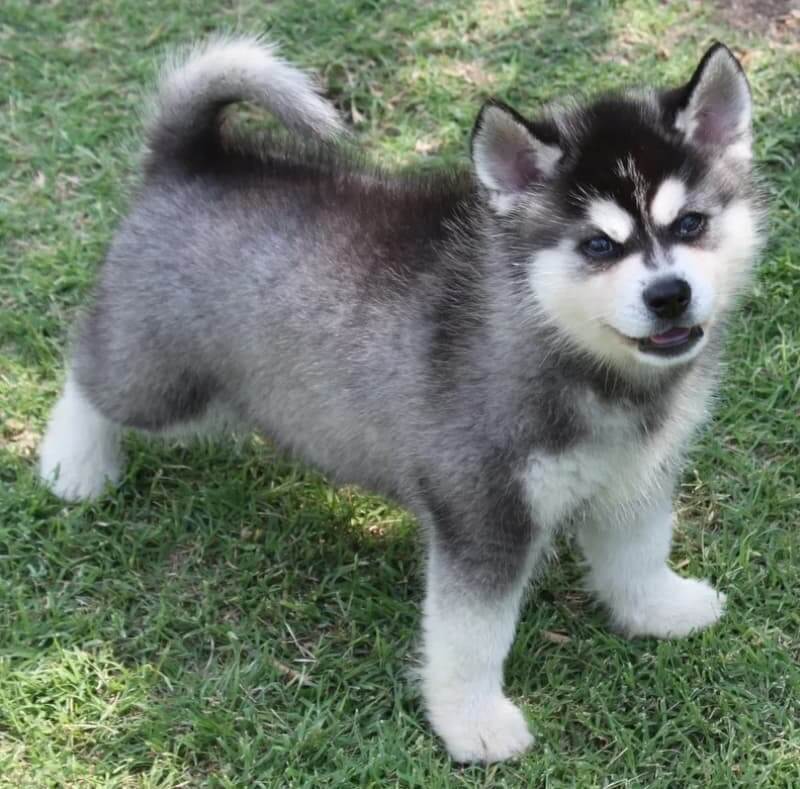The Alaskan klee kai is a relatively new breed of dog, which was created by breeding a Siberian husky and an Alaskan husky. It is characterized by its smaller size and two coats, being both long haired and short haired.
Unlike other breeds of husky, the Alaskan klee kai has been bred for intelligence, high activity, and a lower prey drive. It can also be used for sledding or as a pet in apartment life.
History
The breed was first developed by Linda Spurlin and her family in Wasilla, Alaska, beginning in the early 1970s. Spurlin had admired the Siberian Husky since childhood, and initially sought to breed a smaller version simply.
However, after acquiring a female black and white Husky/Alaskan Malamute cross named “Minnie”, Spurlin began to selectively breed dogs that resembled their wolf-like ancestor, the Siberian Husky.
Initially, the dogs were bred with an eye towards size reduction. However, as the appearance of these miniature huskies stabilized, Spurlin began to select for temperament as well.
Are Alaskan Klee Kai good family dogs?
This breed is an excellent family dog as long as it’s adequately socialized with children and other pets from an early age. Because they are not typical lapdogs, they are best suited for homes with older children or teenagers who can handle them correctly.
Alaskan Klee Kai are not a good choice if you want a dog who will be happy to greet strangers at the door. They are often aloof with strangers, and may take some time to warm up to new people in their home.
This can make them seem unfriendly or unapproachable, but they are just a little wary of new people in their territory. Once they get to know you, this breed makes an affectionate and loving companion.

Characteristics
Size and Weight
- The American Kennel Club describes the Alaskan Klee Kai as a small-sized dog, “standing from 13 to 15 inches at the withers and weighing from 10 to 15 pounds”;
- The standard for the breed is that they be proportioned like a smaller version of the Siberian Husky, with no specific weight requirement;
- According to the Alaskan Klee Kai Association of America, “Quality is not to be sacrificed in favor of size”.
Health concerns
Though they can be generally described as healthy, there have been some genetic issues that breeders have to work around. One problem is PRA – Progressive Retinal Atrophy.
This is a condition where the eyes’ photoreceptors gradually decay, causing blindness. Furthermore, there is an inherited form of epilepsy in this breed. This condition can be controlled with medication and is not life-threatening.
Personality and temperament
- The Alaskan Klee Kai is an active dog that needs plenty of room to run and play.
- They are intelligent but reserved around strangers, so socialization is important.
- They have a high prey drive and should not be trusted around small animals or birds.
Appearance
The appearance of the Alaskan Klee Kai is similar to that of the Siberian Husky, except that it comes in a smaller package.
There are four color variations: black and white, gray and white (which can range from nearly all gray to nearly all white), red and white, and solid white. The eyes may be brown or blue (or, sporadically, one of each).
Are Alaskan Klee Kai easy to train?
Alaskan Klee Kai are intelligent, independent, and stubborn. They will not respond well to harsh training methods. Positive reinforcement is the best approach because Alaskan Klee Kai tend to be sensitive animals. They can be fearful of new situations, so early socialization is important. Don’t force your Alaskan Klee Kai into a situation that scares him.
To prevent behavior problems from developing, socialize your Alaskan Klee Kai puppy at an early age by exposing him to new people, sights, sounds, and experiences. This will promote confidence and help prevent fearfulness or other behavioral issues from developing as he grows up.
How much does a Klee Kai cost?
The average price for a Klee Kai puppy is $2,000–$3,000, which is expensive. However, they are very rare dogs, and you’ll likely have to get on multiple waiting lists before you can get your hands on one.
Conclusion
The Alaskan klee kai thrives in cold conditions with plenty of exercise, but can thrive in warmer climates given adequate habitat. The key to their care is simply ensuring the dog gets enough exercise and attention.
Not only that, they’re easy to train, given they’re highly intelligent dogs. Alaskan klee kai are a great, versatile breed that’s always up for an adventure.


